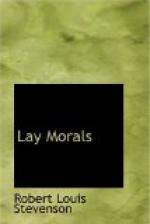But Mr. Tatler’s best performances were three short papers in which he hit off pretty smartly the idiosyncrasies of the ‘Divinity,’ the ‘Medical,’ and the ‘Law’ of session 1823-4. The fact that there was no notice of the ‘Arts’ seems to suggest that they stood in the same intermediate position as they do now—the epitome of student-kind. Mr. Tatler’s satire is, on the whole, good-humoured, and has not grown superannuated in all its limbs. His descriptions may limp at some points, but there are certain broad traits that apply equally well to session 1870-1. He shows us the divinity of the period—tall, pale, and slender—his collar greasy, and his coat bare about the seams—’his white neckcloth serving four days, and regularly turned the third’—’the rim of his hat deficient in wool’—and ‘a weighty volume of theology under his arm.’ He was the man to buy cheap ’a snuff-box, or a dozen of pencils, or a six-bladed knife, or a quarter of a hundred quills,’ at any of the public sale-rooms. He was noted for cheap purchases, and for exceeding the legal tender in halfpence. He haunted ’the darkest and remotest corner of the Theatre Gallery.’ He was to be seen issuing from ‘aerial lodging-houses.’ Withal, says mine author, ’there were many good points about him: he paid his landlady’s bill, read his Bible, went twice to church on Sunday, seldom swore, was not often tipsy, and bought the Lapsus Linguae.’
The medical, again, ’wore a white greatcoat, and consequently talked loud’—(there is something very delicious in that consequently). He wore his hat on one side. He was active, volatile, and went to the top of Arthur’s Seat on the Sunday forenoon. He was as quiet in a debating society as he was loud in the streets. He was reckless and imprudent: yesterday he insisted on your sharing a bottle of claret with him (and claret was claret then, before the cheap-and-nasty treaty), and to-morrow he asks you for the loan of a penny to buy the last number of the Lapsus.




